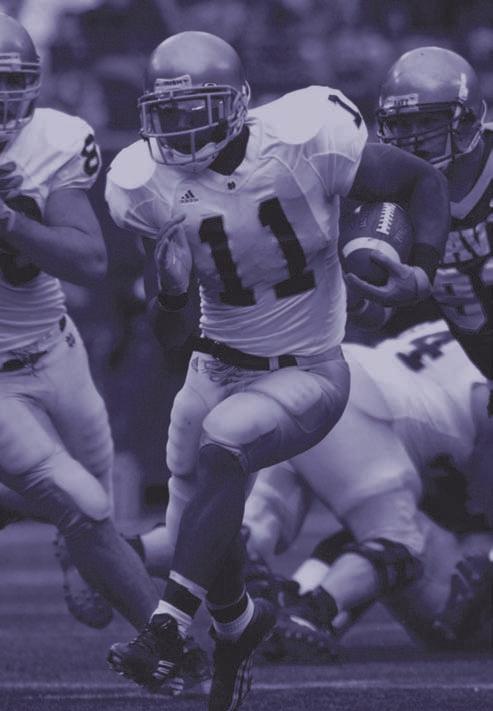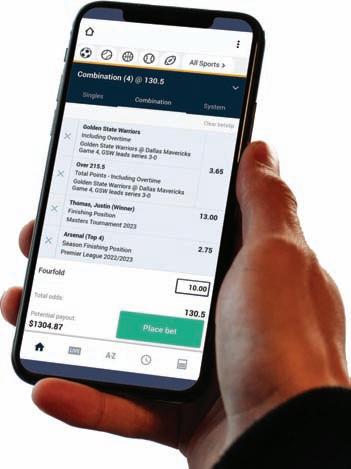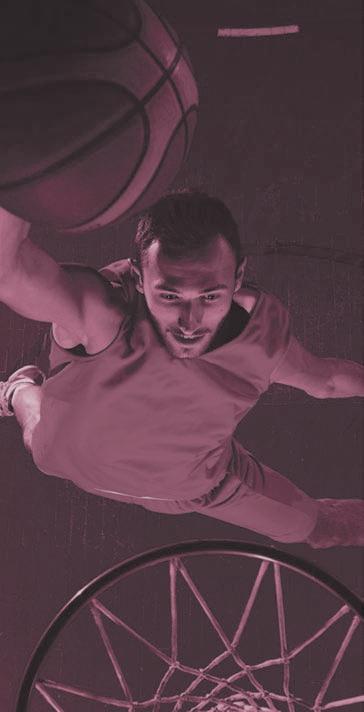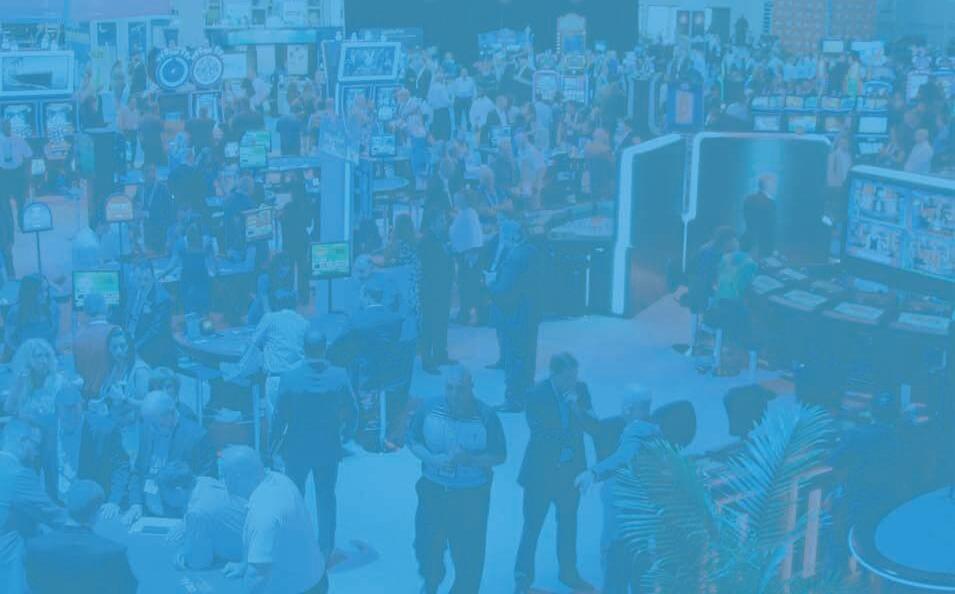
10 minute read
INSTANT ACTION
Micro betting brings constant acton—and big revenues— to the sports betting business

Advertisement
By Dave Bontempo
Gaming hails The Great Multiplier. Micro betting, the in-game phenomenon for legalized sports wagering, is part of the multibillion-dollar tailwind blowing across state gambling jurisdictions. Just as the bonus trigger spikes the payout of an online slot, micro betting propels sports-betting revenues within each contest. Predict the next at-bat, basket or whether the following play is a run or pass. Wager on the immediate result of the next sequence. Capitalize on a hunch. Technology supporting this practice goes to the heart of human nature itself. Gamblers love side action. Micro betting is the sports equivalent of a wildcard wager on the next card, a one-roll “hi-lo” dice toss seeking 2 or 12, even a double-down on two blackjack picture cards, face up. Action, action, we want action.
Gamblers craving immediate results within the large overall contest are getting it.
The Market Grows
This dynamic surges amid the growing American online sports-wagering market. On March 10, Massachusetts became the latest state to green-light mobile betting. That unfolds just in time for the lucrative March Madness basketball tournament.

According to Legal Sports Report, there are 30 states with legalized wagering. They have accounted for more than $200 billion of betting handle, $15 billion in revenue and $2.5 billion tax revenues to states since 2018.
All of this has unfolded with a relatively friendly 7.7 percent betting hold, meaning that customers believe they have a fair shot at winning. If revenues are to spike, more options must be made available.
Micro betting adds fuel to that roaring fire.
It also adds a cat-and-mouse dynamic between gamblers and operators. Players scout deals, knowing that an NFL first-down incompletion may take a team from plus numbers to minus numbers, thereby negating value. The under on an over-under run line can change from +150 to -210 if a basesloaded double play gets a team out of the inning.
Timing, the fuel of micro betting, is crucial.
Both casual players and big gamblers try wagering into a sweet spot. Micro betting also fits the reduced attention span of the instant-gratification age. Some gamblers don’t want one result in a two-hour period. They want 20.
This progression points to ingame wagering exceeding pre-game betting and perhaps driving 50 percent of overall revenue in the coming years.
Riches await companies able to service this trend, and two in particular have emerged.
Kambi, based in England, earned the pole position of American operators with the 2018 repeal of the federal sports-betting ban. Rather than build time-consuming sports-betting models, casino companies can enlist Kambi for a turnkey operation. For those who did so over the last four years, becoming instantly ready for the lucrative NFL season was worth this partnership.
Simplebet has specialized in the next-bet realm and become an industry leader. This is a lightly tapped area with room to grow.
The ascent of Simplebet and Kambi mirror the larger surge in sports betting.

A Fantastic Serve
Kambi officials note that although the significance of micro betting, or instant betting as they call it, has catered to international sports for a long time, it was first offered with tennis in 2011. The stakes have increased substantially.
The company has long been ahead of the curve to anticipate the explosive U.S. market. That diligence includes everything from cultivating relationships with American-based companies to opening an office in the United States.
Kambi has provided several facilitation levels for operators looking to power their own books or use Kambi to essentially run them. Here are some conceptual overviews the London-based company shared with GGB:
• The popularity of instant betting really took off in the United States and has become a key battleground for operators. Some of the most popular U.S. sports like football, basketball and baseball have a certain cadence to the flow of the game that makes instant-betting exciting for players.
• Bettors today look for immediate outcomes, and these fast-settling bets are perfect for player engagement. For these popular U.S.-facing sports, bettors can wager on the result of the next drive in a football game, the result of the next pitch in baseball being a ball or a strike, and the next basket made in a basketball game being a 2 or 3 pointer.
• A key contributing factor to growing in-play is the regulation of mobile betting. In states that have introduced mobile betting from the onset, as opposed to solely on-property, the rate of engagement with the in-play offering is understandably larger—with mobile being more conducive to in-play betting—and the split between pre-match and live is much closer on mobile than on-property.

Specific applications of those principles have unfolded with the rapid ascension of in-game betting.
The Kambi network shows that over the years, instant betting is growing at a faster pace than pre-game. In 2022, the company saw a pre-game/ live split of about 60 percent/40 percent, proving that the demand for instant betting continues to be of high interest across the industry.
After initially offering instant betting for tennis with point winner breaks, it’s been able to expand these types of offerings across various sports over the last decade.
This includes a leading penalty shoot-out offer for soccer, which has yet to have been matched, and even wagers on how a particular penalty will be missed, officials say.
A perfect example of its popularity is from the World Cup match between Morocco and Spain, where Kambi expanded its offering into soccer with next throw-in. They later added it to American sports such as baseball with “Will the batter record a hit or a walk?”
It remains a core part of the live offering as instant betting is often in the top 10 most popular in-game markets. The major U.S. sports contain multiple discreet units, or individual data points around which betting markets can be created. As a result, they lend themselves well to an effectively de- ployed instant-betting ecosystem.
The company believes it cannot overstate the need for urgency in staying ahead of the game’s developments. The power and complexity required to present instant markets in a seamless, automated manner to the bettor, with low delays, is exceptionally significant. So is the expertise this requires in proprietary pricing.
The growing popularity of instant betting clearly illustrates the need for a best-in-class sportsbook, underpinned by proven, high-performance technology in meeting the demands of the modern player.
Through a blend of official data providers, sophisticated models and highly skilled traders, players can continue to enjoy wagering on an event long after the outcome has been decided.
Kambi research also showed that instant bettors are often more valuable than those who aren’t betting live. That’s because live in-game gamblers are engaged with the sportsbook through the entirety of a game, even if the outcome has already been decided.
Players can still bet on the next pitch being a ball or strike in a 17-3 game in the eighth inning if they are so inclined.
Creating a compelling instant offer comes with its own challenges, however. It needs to be a friction-free user experience to avoid latency issues, or live delays, and needs to have accurate and fast settlements with fewer bet rejections. Having the technology in place and a strong core platform can present a huge range of instant markets in a seamless way, avoiding any delays.
The data received needs to be fast, accurate, and granular enough to offer these markets at the right time and settle them correctly, which also requires trading expertise.
Kambi has a huge richness of data across more than 40 partners around the world, which allows it to effectively manage price and risk. This allows operators to retain a reasonable profit margin, Kambi officials say.
Micro Managing Riches
Co-founded in 2018 by Chris Bevilacqua, Joey Levy and Scott Marshall, Simplebet is the technology company pioneering micro betting and fan engagement for U.S. sports.
What sets Simplebet apart is its singular focus on micro betting, the company indicates. This innovative approach to sports betting gives sports fans a path to engage with betting on a game the way it’s watched—mo- ment by moment. “I bet the Cowboys to run on this play’” is now a betting opportunity.

Simplebet provided in-game markets for over 6,000 games in 2022 across the NFL, NBA, MLB, and college football and basketball, according to its COO Mark Nerenberg. The possibilities for different user experiences, different strategies, different content are endless.
“We see our micro markets accounting from 15 percent to 35 percent of in-play revenue depending on the sport,” Nerenberg says. “And across the five leagues we cover (the five most popular to bet on in the U.S.—NFL, NBA, MLB, CFB, CBB) live betting accounts for maybe 35 percent of revenue (pre-match accounting for the other 65 percent).
“I think three years from now micro betting will account for over 50 percent of live-betting volume and revenue, and live betting will surpass pre-match as the predominant form of betting as well. Micro betting is really in its early stages right now.”
Simplebet officials knew that the concept of micro betting was not new when it launched. Tennis had already been long established.
Even betting on the result of certain drives in the NFL or at-bats in MLB were offered in the U.S. right away in 2018 when online sports betting became legal for the first time in New Jersey.

But the company believed there had not been enough industry traction due to a lack of coverage and “availability.”
“Four years ago, when we decided to go all in on micros, our hypothesis was that micro markets require a certain level of up-time (“availability”) to achieve significant user adoption and stickiness,” Nerenberg asserts.
“I’d say that by the end of 2021 micro betting had proven to be far more significant than the majority of industry insiders would have thought,” he says. “Drives and Plays accounted for 25 percent of live-betting volume on DraftKings for the Super Bowl and peak college bowl season. At that time, drive markets at other books were accounting for maybe 3 percent of livebetting volume. So after three years of building a fully automated micro market pricing engine we had finally proven our hypothesis.”
And so came the march forward. The company steadily enhanced its footprint, matching the public appetite for the game within the game. The emergence of technology to meet that demand could not be more timely.
“Over the past year we have seen a great increase in demand in the market for micro betting from operators,” Nerenberrg asserts. “In September we went live with Bet365, which was incredibly validating, as they are the global leader in live betting. We also added Caesars sportsbook as a partner, going live in their app this past December.”
In 2022, Simplebet partnered with Betr, a startup co-founded by Joey Levy and Jake Paul, to launch a sportsbook entirely centered around the micro-betting experience.
“When it comes to demand from users and sports fans, we have a long way to go,” Nerenberg says. “Micro betting has proven to be engaging and sticky among users that find these markets within the app, but the biggest gap right now is awareness and education for consumers.”
Nerenberg contends there has been very little marketing behind micro betting. Most sports fans don’t even know it exists. Additionally, there is significant room for improvement with the user experience.
With micro markets, users do not have enough time to scroll through long lists of markets to find bets. Operators have work to do when it comes to providing relevant information in real time and presenting users with the right bet at the right time to create a more frictionless experience, he adds.
From the technological perspective, success methods vary. “Our approach is definitely different from what exists in the market currently, which we believe is necessary for the type of scale and availability we provide to achieve these unprecedented levels of user adoption and control of hold,” he says.
“Creating and repricing dozens of markets on every play in a football game and every pitch of a baseball game requires a level of automation where probabilities of every outcome from every market we create and reprice are powered entirely by machine learning models. These models leverage historical data as well as live data to make predictions on what will happen given the exact situation in the game.”
Nerenberg says that with machine-learning engineering that enables these models to run in subseconds, infrastructure to constantly optimize and retrain models and automation for tracking the exact state of the game in real time, Simplebet has a winning formula.
“Our level of automation is probably not as necessary for other types of in-play markets,” he says, “but we believe our approach does present opportunities to provide superior offerings across all of in-play at scale and we will be expanding beyond micro markets to prove this out in 2023.”
The next major market feat could become FOMO, the fear of missing out. Users who discover that micro markets are highly engaged and micro betting is driving significant engagement and incremental GGR for operators may feel compelled to join the party.
“I think once you have more content providers and broadcasters authentically including micro predictions into their content it will become a real problem for operators that do not have a quality offering,” he says.
“I remember watching a game where Troy Aikman predicted an Amari Cooper touchdown for the upcoming play, and sure enough that is exactly what happened. Unfortunately, neither Troy nor the majority of viewers knew that you can actually make that exact bet in real time.

“I am sure Troy had some interesting logic for how he arrived at that prediction. Once micro betting starts getting real exposure on platforms where fans are already consuming live sports… that’s when micro betting starts to really impact market share for even the largest operators.”
And that time is coming.
Operators, sportsbooks and state governments love the nuance springing from this market niche.
Crunching the numbers, right down to the odds of the next play, has never been so meaningful.
Global Gaming Business presents the annual publication Progressive Products Preview, or P3 With tremendous innovation taking place in the international gaming industry, P3 showcases the cutting-edge technologies, products and services that are shaping the future of the casino industry.















